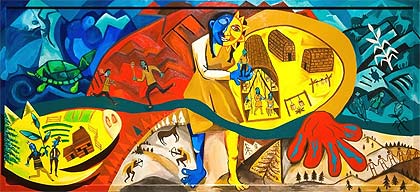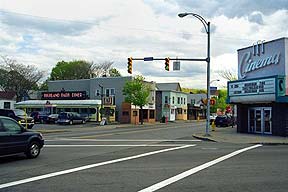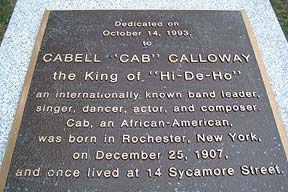Southeast Quadrant - Swillburg
 While some neighborhoods may try to erase its more humble origins, the Swillburg Neighborhood relishes its past. Native-Americans once traversed an east-west trail within the small triangular-shaped area. Canal boats later moved through the nearby Lock 66 of the Erie Canal bringing European settlers to a new western frontier.
While some neighborhoods may try to erase its more humble origins, the Swillburg Neighborhood relishes its past. Native-Americans once traversed an east-west trail within the small triangular-shaped area. Canal boats later moved through the nearby Lock 66 of the Erie Canal bringing European settlers to a new western frontier.
Legend has it that the owner of a large pig farm in the 1800s, Mr. George Goebel, collected “swill” for his swine alongside the Erie Canal. The name, if not the pig production, remained. Today, the Swillburg Neighborhood Association promotes its porcine history from its Happy Pig logo on its street signs to the masthead of its newsletter, The New Porker.
Swillburg’s diversity and down to earth village ethos continues to draw residents who fill the 20-block neighborhood, which is filled with narrow streets and 19th century homes. Its boundaries extend to Field Street on the east and Rt. 490 on the north. Its western border is marked by Meigs Street (South Clinton to Rt. 490) and on the south by South Clinton Avenue (east side from Meigs Street to town of Brighton).
 Its main shopping area, South Clinton Avenue, has grown into a mecca for lovers of international cuisine. Choices include Indian, Chinese, Somalian, Vietnamese and Japanese restaurants.
Its main shopping area, South Clinton Avenue, has grown into a mecca for lovers of international cuisine. Choices include Indian, Chinese, Somalian, Vietnamese and Japanese restaurants.
Swillburg is also home to the landmark Cinema Theatre, one of U.S.’s oldest continuously running movie theaters, which opened its doors in 1914. First named The Clinton, it offered wooden benches and a dirt floor. By 1949, The Clinton was renamed The Cinema during a renovation that added an Art Deco façade that remains today. Most recently, the marquee was electrified through the neighborhood fundraising efforts. Tickets still remain $5. Across the street, the picturesque 1930’s Highland Diner is still open for business. Down nearby Henrietta Street, upscale Rooney’s Restaurant draws visitors from throughout the Rochester area.
Swillburg also benefits from collaboration with The South East Area Coalition (SEAC), a non-profit organization that works to preserve, develop and sustain the character of neighborhoods. Its ESCAPE (Evolving South Clinton Avenue Places and Environment) Committee brought residents and other area stakeholders together to reinvigorate this vital avenue. Over the last several years, the group has worked together to improve the streetscape (sidewalks, curbs, benches, flower-filled planters and streetlights) and has hired local artists to create urban art murals on traffic control boxes. It also welcomed a $9 million project of The Association for the Blind and Visually Impaired (ABVI) that included a state-of-the art Call Center on South Clinton Avenue. In 2014, SEAC joined with the South Wedge Planning Committee (SWPC) and today shares facilities and staff.
 The Swillburg Neighborhood Association actively looks for ways to enrich the area along with the Pembroke and Benton Street Block Clubs. The Association organizes events throughout the year including a Halloween scavenger hunt, a holiday decorating contest, and the annual Swillfest, a night of good food and music. In the summer, the Rochester Philharmonic Orchestra holds free concerts in Swillburg’s Otto Henderberg Park. The Park, created in 1980 in an area leveled to make way for the Genesee Expressway, honors Henderberg’s efforts in keeping Swillburg from being split in two by the road. This small green space, on Sycamore and Fountain Street, commemorates iconic jazz bandleader Cab Calloway, who lived the first several years of his life at 14 Sycamore Street (the house has since been demolished).
The Swillburg Neighborhood Association actively looks for ways to enrich the area along with the Pembroke and Benton Street Block Clubs. The Association organizes events throughout the year including a Halloween scavenger hunt, a holiday decorating contest, and the annual Swillfest, a night of good food and music. In the summer, the Rochester Philharmonic Orchestra holds free concerts in Swillburg’s Otto Henderberg Park. The Park, created in 1980 in an area leveled to make way for the Genesee Expressway, honors Henderberg’s efforts in keeping Swillburg from being split in two by the road. This small green space, on Sycamore and Fountain Street, commemorates iconic jazz bandleader Cab Calloway, who lived the first several years of his life at 14 Sycamore Street (the house has since been demolished).
In 2009, the Neighborhood Association commissioned Maria Friske to create a work for the I-490 wall on Pembroke Street (between South Goodman Street and Monroe Avenue). They received funding through The Arts & Cultural Council's Culture Builds Communities Grant Program.
Friske’s piece, five 4’x10’ steel painted panels, depicts Swillburg history from the 18th century to today. The panels include references to Native American deities and figures, early canal and pig-farming days, the Underground Railroad and local residents both famous (Cab Calloway) and unknown who made Swillburg the lively city neighborhood it is today.
Additional Information
If you would like additional information on this neighborhood, please contact the Southeast Quadrant Neighborhood Service Center:
320 N Goodman St - Suite 209
Rochester, New York 14607
(585) 428-7640
Email: Erica.Hernandez@cityofrochester.gov